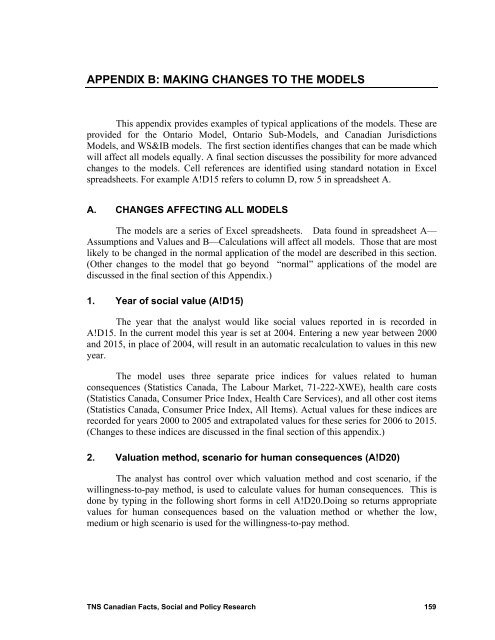Keith Vodden Dr. Douglas Smith - Transports Canada
Keith Vodden Dr. Douglas Smith - Transports Canada
Keith Vodden Dr. Douglas Smith - Transports Canada
Create successful ePaper yourself
Turn your PDF publications into a flip-book with our unique Google optimized e-Paper software.
APPENDIX B: MAKING CHANGES TO THE MODELS<br />
This appendix provides examples of typical applications of the models. These are<br />
provided for the Ontario Model, Ontario Sub-Models, and Canadian Jurisdictions<br />
Models, and WS&IB models. The first section identifies changes that can be made which<br />
will affect all models equally. A final section discusses the possibility for more advanced<br />
changes to the models. Cell references are identified using standard notation in Excel<br />
spreadsheets. For example A!D15 refers to column D, row 5 in spreadsheet A.<br />
A. CHANGES AFFECTING ALL MODELS<br />
The models are a series of Excel spreadsheets. Data found in spreadsheet A—<br />
Assumptions and Values and B—Calculations will affect all models. Those that are most<br />
likely to be changed in the normal application of the model are described in this section.<br />
(Other changes to the model that go beyond “normal” applications of the model are<br />
discussed in the final section of this Appendix.)<br />
1. Year of social value (A!D15)<br />
The year that the analyst would like social values reported in is recorded in<br />
A!D15. In the current model this year is set at 2004. Entering a new year between 2000<br />
and 2015, in place of 2004, will result in an automatic recalculation to values in this new<br />
year.<br />
The model uses three separate price indices for values related to human<br />
consequences (Statistics <strong>Canada</strong>, The Labour Market, 71-222-XWE), health care costs<br />
(Statistics <strong>Canada</strong>, Consumer Price Index, Health Care Services), and all other cost items<br />
(Statistics <strong>Canada</strong>, Consumer Price Index, All Items). Actual values for these indices are<br />
recorded for years 2000 to 2005 and extrapolated values for these series for 2006 to 2015.<br />
(Changes to these indices are discussed in the final section of this appendix.)<br />
2. Valuation method, scenario for human consequences (A!D20)<br />
The analyst has control over which valuation method and cost scenario, if the<br />
willingness-to-pay method, is used to calculate values for human consequences. This is<br />
done by typing in the following short forms in cell A!D20.Doing so returns appropriate<br />
values for human consequences based on the valuation method or whether the low,<br />
medium or high scenario is used for the willingness-to-pay method.<br />
TNS Canadian Facts, Social and Policy Research 159
















